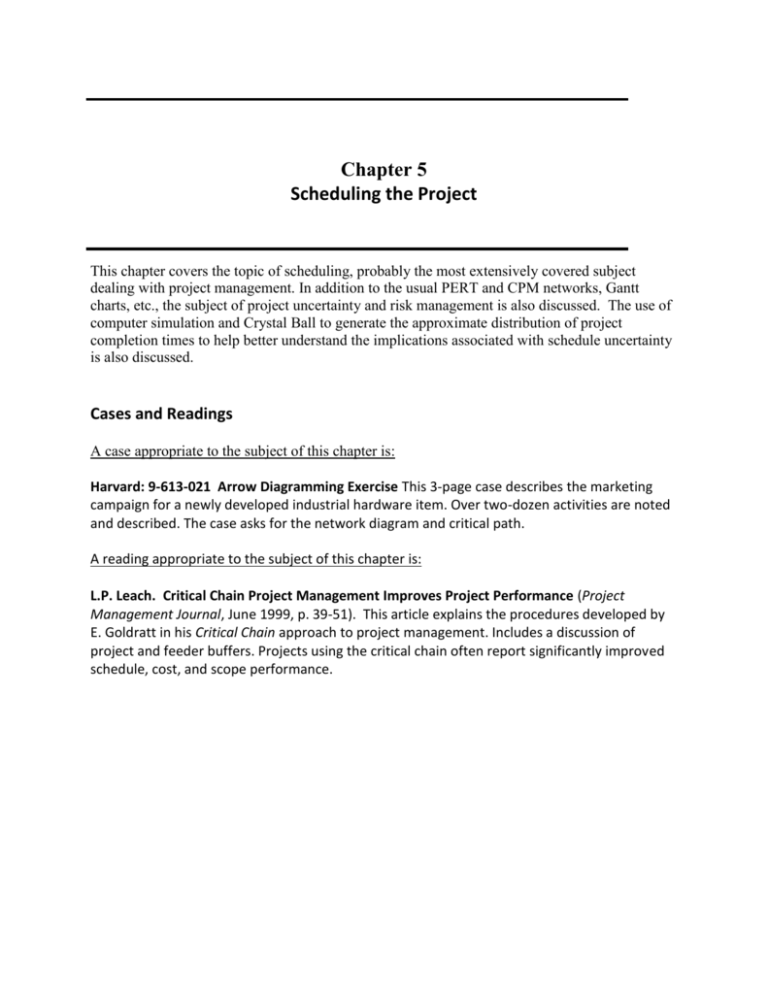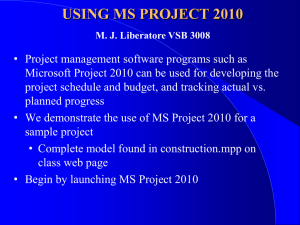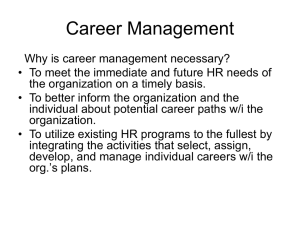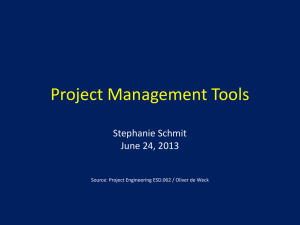Project Scheduling: PERT, CPM, Risk Management & Simulation
advertisement

Chapter 5
Scheduling the Project
This chapter covers the topic of scheduling, probably the most extensively covered subject
dealing with project management. In addition to the usual PERT and CPM networks, Gantt
charts, etc., the subject of project uncertainty and risk management is also discussed. The use of
computer simulation and Crystal Ball to generate the approximate distribution of project
completion times to help better understand the implications associated with schedule uncertainty
is also discussed.
Cases and Readings
A case appropriate to the subject of this chapter is:
Harvard: 9-613-021 Arrow Diagramming Exercise This 3-page case describes the marketing
campaign for a newly developed industrial hardware item. Over two-dozen activities are noted
and described. The case asks for the network diagram and critical path.
A reading appropriate to the subject of this chapter is:
L.P. Leach. Critical Chain Project Management Improves Project Performance (Project
Management Journal, June 1999, p. 39-51). This article explains the procedures developed by
E. Goldratt in his Critical Chain approach to project management. Includes a discussion of
project and feeder buffers. Projects using the critical chain often report significantly improved
schedule, cost, and scope performance.
Answers to Review Questions
1. How would a PM manager critical path tasks differently than noncritical tasks?
By definition, critical tasks are those tasks that if delayed will delay the completion of the
entire project. Therefore, these tasks should be managed more closely than non-critical
tasks.
In cases where the activity times are not known with certainty, the tasks assumed to be
critical at the beginning of the project may turn out not to be so critical. Therefore, when
tasks times are uncertain, all tasks that may reasonably delay project completion must be
carefully managed.
2. How is slack determined?
Slack for a particular task is calculated by:
o Subtracting the earliest time the task can start from the latest time the task can start,
o Subtracting the earliest time the task can finish from the latest time the task can finish.
Both calculations result in the same slack and indicate a window in which the task can be
started and finished without delaying the entire project.
The slack for a particular path is calculated by subtracting the path’s duration from the
critical path’s duration and provides an indication of how much the path can be delayed
without delaying the completion of the project.
3. How do you determine the EST for an activity with two predecessors? How do you
determine the LFT for an activity with two successors?
The earliest start time for an activity with two predecessors is equal to the later earliest
finish time of the two predecessors since both predecessors must be completed for the task
to begin.
The latest finish time for an activity with two successors is equal to the smaller latest start
time of the two successors. If the larger were used, then the preceding task would be
permitted to finish after the latest start time of the other successor.
4. Will all activities on a noncritical path have the same slack? Why or why not?
No, all activities on the same non-critical path will not necessarily have the same slack.
This is because a particular activity may be on multiple paths. When an activity is on more
than one path, its slack is determined by the path with the least amount of slack.
5. For the following project,
(a) List all predecessors of task 5.
(b) List all predecessors of task 4.
(c) List all predecessors of the network finish (F).
Note: As pointed out in Section 3.3, p.75, only immediate predecessors should be listed.
(a) Task 4 is the only immediate predecessor of task 5.
(b) Tasks 2 and 3 are both immediate predecessors of task 4.
(c) Task 5 is the immediate predecessor of the network finish (F).
6. What is a dummy activity?
When two activities have the same beginning and ending nodes they do not have a unique
identity in the project network. To solve this problem a new ending or starting node is
created for one of the activities to provide them with a unique identity. Then a dummy
activity or an activity with no duration is added to preserve the precedence relationship.
7. Consider Figure 5-14. Paths a-b-c and a-b-d converge at activity f, but we ignore this
potential merge problem in the text. Why?
Activities a and b are common to both paths and so do not need to be considered. They
must take the same impact on both paths.
Note: We did consider the partial paths d-g-h and c-f.
8. What is meant by “project slack”?
If the promised delivery date for a project is greater than the time required to complete the
project, the project is said to have “project slack.”
The amount of the project slack is equal to the delivery time minus the project completion
time.
9. When using AON networks, how does one indicate an event such as a project milestone?
A milestone could be added as a node to the AON network with zero duration.
10. A probabilistic network has a critical path of 21 days and a .95 probability of completing
this path in 24 days. Therefore, the project has a .95 chance of being finished by the end
of the 24th day. True or False? Briefly explain your answer.
False.
Only the path claimed to be critical has a 95 percent chance of being completed within 24
days. However, there may be one or more other paths that also have a chance of taking
longer than 24 days.
If we are comfortable making the assumption that the paths are independent of one
another, then the probability the project will be completed in 24 days or less can be
calculated as the product of the probabilities that each path is finished on or before day 24.
11. “Not uncommonly, the Gantt chart is deceptive in its apparent simplicity.” Briefly explain.
Because the Gantt chart is so easy to construct and read, people may use this tool with little
project management training and no technical knowledge about the project. One danger is
drawing conclusions and making decisions based on the relatively simple information
displayed in the chart.
12. When activity times are known with certainty, the critical path is defined as the set of
activities on a path from the project’s start event to its finish event that, if delayed, will
delay the completion date of the project. Why must this definition be modified in
situations where the activity times are not known with certainty?
In cases where the activity times are not known with certainty, it is not possible to
determine the actual duration of each path. Therefore, it is not possible to determine the
critical path a priori.
A path that is determined to be critical at the beginning of the project based on expected
activity durations may turn out not to be critical when the project is half completed,
perhaps as a result of the extra management attention this path received. Indeed, it is
common for the status of various paths to alternate between being critical and not being
critical as the project is completed.
Are there dangers associated with not modifying the definition?
One danger is that what is thought to be the critical path at the beginning of the project
consumes all of management’s attention only to have other paths fall behind and actually
end up delaying the project. The implication is that all paths that have the potential to
delay the project should be appropriately managed.
Suggested Answers to Discussion Questions
13. How might you use the network approach to help prepare cost estimate?
One way to use the network approach to prepare cost estimates would be to simply
estimate the cost of each task in the diagram and then sum these costs up. The time
estimates for the activities would likely be of significant help in estimating some of the costs
(particularly when human labor is required), and developing a cash flow schedule.
14. When would it be accurate to determine the probability of project completion by
multiplying the probabilities of all the paths through the network together?
It would be accurate to multiply the probabilities together when the paths are independent
of one another.
When would it not be accurate?
In reality, the paths are not likely to be truly independent because the paths have activities
in common and common resources are shared across paths. This latter point is particularly
noteworthy as the network diagram only shows technological precedence relationships and
most often does not include information about how the resources will be allocated.
In many textbooks it is common to argue that while true independence across the paths is
rarely met, statistical independence is achieved for large network diagrams with only a few
violations. Of course, the typical homework-type problems assigned are not large enough
to justify the independence assumption and the calculations required for realistically-sized
network diagrams would be far too tedious for most managers. That is why simulation is
the recommended approach in this text. However, it is important to note that
understanding the statistical approach facilitates understanding the simulation approach.
15. Reconcile Question 14. If this approach is not accurate, would the probability of
completion considering the critical path alone be more accurate?
No, the probability would not be more accurate if only the critical path were considered
unless this one path was much longer than all the other paths. In this case the other paths
would have virtually no chance of delaying the entire project. When activity times are
uncertain, properly calculating the probability that the project is completed by a certain
date requires considering the probability that all paths are completed by the specified date.
How might you estimate the correct probability without resorting to simulation?
If the assumption of path independence is reasonable then the product of the probability of
each path completing by the specified time can be calculated. Otherwise, simulation must
be used.
16. Why do you think most PMs use MSP’s Gantt chart format (see Figure 5-24) more
commonly than the network format?
It is much more intuitive, easier to read, and may contain much more information relevant
to the project.
17. Which of the linkages in precedence diagramming do you think is most commonly used?
Why?
As noted in the chapter, the finish-to-start is the most commonly used linkage because
typically certain activities must be completed before other activities can start.
The start-to-start and finish-to-finish linkages are occasionally applicable. In these cases
certain activities must either be started or finished at the same time. The start-to-finish
linkage is probably used the least frequently.
18. In the calculation of variance for optimistic and pessimistic activity duration estimates
made at the 95 or 90 percent level, the denominator of the fraction that approximated
the standard deviation of the time distribution changes from the traditional (b - a)/6 to
(b - a)/3.3 for 95 percent and to (b - a)/2.6 for 90%. Where did the 3.3 and the 2.6 come
from?
The 3.3 corresponding to 95 percent is based on a z-value of 1.645 which has 5 percent of
the area in the upper tail. Doubling this yields the 3.3 given in the text. Note that the 3.3 is
appropriately used when management specifies an optimistic time estimate that has a 95
percent chance of being achieved and a pessimistic time estimate that has only a 5 percent
chance of being exceeded.
The 2.6 corresponding to 90 percent is based on a z-value of 1.28 which has 10 percent of
the area in the upper tail. Doubling 1.28 yields the 2.6 given in the book. Again, the 2.6 is
appropriately used when management specifies an optimistic time estimate that has a 90
percent chance of being achieved and a pessimistic time estimate that has only a 10 percent
chance of being exceeded.
19. Given all the estimating done to determine the duration of project activities, what does it
mean to say that “only after the fact do we know which path was actually the critical
path”?
When activity times are uncertain, we can only estimate how long they will actually take.
This means that we can only estimate the duration of the paths also. Since these are only
estimates, we will not know for certain which path actually took the longest to complete
until the project is complete.
20. It was noted that “the PM must manage the project team as well as the project.” Explain
why.
There are actually two sets of trade-offs project managers must make. Most commonly, we
talk about making trade-offs between cost, schedule, and performance. However, there is
often another set of trade-offs the project manager must deal with.
Project managers must often make trade-offs between achieving the project goals and the
project team viability. Managing this second set of trade-offs is what is meant by managing
the project team while the first set of goals refers to managing the project.
21. Why do you think scheduling has been the major focus of effort throughout the history of
project management rather than performance or budgeting?
Performance … the performance of a project is measured by three criteria: is it on time? Is
it on budget? And does it meet the agreed-upon specifications? These are outcomes which
depend, to a large extent, on the effectiveness of the planning process which, in turn,
depends on the quality of the scheduling?
Budgeting … as pointed out at the beginning of the chapter, one cannot prepare a budget
without knowing the specifics of each task and the time period(s) during which the task
must be undertaken. The effectiveness of the budgeting process therefore depends on the
accuracy of the scheduling.
Thus, both performance and budgeting rely on the scheduling … and the more effective that
is, the more likely the later stages (i.e., performance and budgeting) will be.
Solutions to Problems
22.
The expected duration and variance of path a-b-c-f are 44.5 (10 4/6 + 12 1/6 + 12 2/6 +
9 2/6) and 6.47 (1.78 + .25 + 4.00 + .44) respectively.
The probability that this path will take longer than 50 weeks and therefore interfere with
the project completion can be calculated as follows:
z
50 44.5
6.47
2.17
From Appendix A, the area in the upper tail for a z-value of 2.17 can be easily calculated as
1.5%. This means there is a 98.5% chance that this path will not interfere with the project
being completed in 50 weeks.
The probability that both paths finish by time 50 (assuming the paths are reasonably
independent of one another) is .985 .86 = 84.71%.
23.
Occasionally, students make the assumption that by 95% we mean that there is a 95%
probability that the task will be completed within the range defined by the optimistic and
pessimistic range. In these cases, (b-a) should be divided by 3.92, rather than 3.3.
The spreadsheet below provides the solutions for the 99+ percent probability estimates, as
well as the 95% estimates using both the 3.92 and 3.3. Students may find the use of 3.92
more intuitive. Using this factor, the probability that path a-b-d-g-h finishes on or before
time 50 is 76.5%.
A
1
2
3
4
5
6
7
8
9
10
11
12
13
14
15
16
17
18
19
Activity
a
b
c
d
e
f
g
h
a-b-d-g-h
Std Dev
Prob
B
Opt.
a
8
11
7
6
10
6
5
4
C
Norm.
m
10
12
12
6
14
10
10
8
D
Pess.
b
16
14
19
6
20
10
17
11
E
TE
10.67
12.17
12.33
6.00
14.33
9.33
10.33
7.83
47.00
F
Var.
((b-a)/6)2
1.78
0.25
4.00
0.00
2.78
0.44
4.00
1.36
7.39
2.72
86.5%
G
H
Var.
Var.
((b-a)/3.92)2 ((b-a)/3.3)2
4.16
5.88
0.59
0.83
9.37
13.22
0.00
0.00
6.51
9.18
1.04
1.47
9.37
13.22
3.19
4.50
17.31
4.16
76.5%
24.43
4.94
72.8%
Key Formulas
Cell E12 =E3+E4+E6+E9+E10 {copy to cells F12:H12}
Cell F13 =SQRT(F12) {copy to cells G13:H13}
Cell F 14 =NORMDIST(50,47,F13,TRUE) {copy to cells G14:H14}
If students follow the text and make the assumption that there is a 5% chance of
completing the tasks faster than the optimistic time estimates and there is a 5% chance that
completing the tasks takes longer than the pessimistic time estimates, then the probability
of path a-b-d-g-h finishing on or before time 50 is 72.8%
24.
If students assume that by 90% we mean that there is a 90% probability that the task will be
completed with the range defined by the optimistic and pessimistic range then (b - a)
should be divided by 3.29, rather than 2.6.
The spreadsheet below provides the solutions for the 99+ percent probability estimates, as
well as the 90% estimates using both the 3.29 and 2.6. Students may find the use of 3.29
more intuitive. Using this factor, the probability that path a-b-d-g-h finishes on or before
time 50 is 72.7%. If students follow the text and make the assumption that there is a 10%
chance of completing the tasks faster than the optimistic time estimates and there is a 10%
chance that completing the tasks takes longer than the pessimistic time estimates, then the
probability of path a-b-d-g-h finishing on or before time 50 is 68.4%
A
1
2
3
4
5
6
7
8
9
10
11
12
13
14
15
16
17
18
19
Activity
a
b
c
d
e
f
g
h
a-b-d-g-h
Std Dev
Prob
B
Opt.
a
8
11
7
6
10
6
5
4
C
Norm.
m
10
12
12
6
14
10
10
8
D
Pess.
b
16
14
19
6
20
10
17
11
E
TE
10.67
12.17
12.33
6.00
14.33
9.33
10.33
7.83
47.00
F
Var.
((b-a)/6)2
1.78
0.25
4.00
0.00
2.78
0.44
4.00
1.36
7.39
2.72
86.5%
Key Formulas
Cell E12 =E3+E4+E6+E9+E10 {copy to cells F12:H12}
Cell F13 =SQRT(F12) {copy to cells G13:H13}
Cell F 14 =NORMDIST(50,47,F13,TRUE) {copy to cells G14:H14}
G
H
Var.
Var.
((b-a)/3.29)2 ((b-a)/2.6)2
5.91
9.47
0.83
1.33
13.30
21.30
0.00
0.00
9.24
14.79
1.48
2.37
13.30
21.30
4.53
7.25
24.57
4.96
72.7%
39.35
6.27
68.4%
25
a. Network diagram.
B
E
A
F
C
I
D
H
G
b. Each activity’s EST, EFT, LST, and LFT.
See following spreadsheet:
Activity
A
B
C
D
E
F
G
H
I
EST
0
4
4
8
10
10
8
15
19
EFT
4
10
8
10
14
15
11
19
21
LST
0
4
4
8
15
10
12
15
19
LFT
4
10
8
10
19
15
15
19
21
Slack
0
0
0
0
5
0
4
0
0
c. Alternative paths … and the critical path:
Path
a-b-e-i
a-b-f-h-i
a-c-d-f-h-i
a-c-g-h-i
Duration
16
21
21
17
Critical?
No
Yes
Yes
No
There are, therefore, two critical paths.
d. Each activity’s slack.
See spreadsheet above (section b).
e. The length of time to complete the project.
The project will take 21 (units of time) to complete (i.e., the length of time of the critical
paths).
26.
Note to instructor: In order to familiarize student with MSP’s “Help” facilities, we have not
given precise instructions in the text for changing MSP’s project calendars, and for using
MSP to find slack. If you wish to make these available, they follow:
The MSP calendar must be reset to a 7-day work week from its usual default of a 5-day work
week. To reset the MSP calendar, click “Tools,” and then click “Change working time.” On
the calendar you will note that Saturdays and Sundays for June and July are shaded, i.e.,
nonworking time. Click on each of these days and then click on “Working time.”
Alternatively, you may highlight the entire months of June and July and then click on
“Working time.”
To show slack or float in MSP, click on “View,” then on “More views,” on “Detail Gantt,” and
“Apply.” Activity slack will be shown on the Gantt chart. Then click on “View,” “Table,” and
then “Schedule.” Drag the divider bar to the right, and you will find “Total slack” and “Free
slack” listed in the MSP table. (For these instructions to take effect, project activity data
must have been entered into MSP.)
d
2
i
5
a
b
9
h
e
1
k
6
l
8
j
f
3
7
g
c
4
One way the critical path can be determined is by identifying all paths and calculate their
duration. As shown below, this project has six paths and path b-e-h-j-l is the critical path
with a duration of 40.
Path
a-d-i-k
a-d-h-j-k
b-e-i-k
b-e-h-j-l
b-f-j-l
c-g-j-l
Duration
29
35
35
35
35
35
Critical?
No
No
No
Yes
No
No
The slack for each task is calculated as follows:
Activity
a
b
c
d
e
f
g
h
I
j
k
l
ES
0
0
0
5
7
7
4
16
16
22
24
31
EF
5
7
4
11
16
13
8
22
24
31
34
40
LS
5
0
14
10
7
16
18
16
22
22
30
31
LF
10
7
18
16
16
22
22
22
30
31
40
40
Slack
5
0
14
5
0
9
14
0
6
0
6
0
27.
a.
The spreadsheet below can be used to calculate the expected time and variance
for each activity.
A
1
2
3
4
5
6
7
8
9
10
11
12
13
14
15
16
17
18
19
20
21
22
23
24
25
26
27
28
29
b.
B
Opt.
a
2
3
4
4
4
3
3
Activity
a
b
c
d
e
f
g
C
Norm.
m
4
5
5
6
5
4
5
D
Pess.
b
6
9
7
10
7
8
8
E
F
Var.
((b-a)/6)2
0.44
1.00
0.25
1.00
0.25
0.69
0.69
TE
4.00
5.33
5.17
6.33
5.17
4.50
5.17
G
H
Var.
Var.
((b-a)/3.92)2 ((b-a)/3.3)2
1.04
1.47
2.34
3.31
0.59
0.83
2.34
3.31
0.59
0.83
1.63
2.30
1.63
2.30
Expected Variance Variance Variance
Duration Column F Column G Column H
14.83
2.14
5.01
7.07
19.50
1.64
3.84
5.42
15.67
1.94
4.56
6.43
Paths
a-d-f
a-c-e-g
b-e-g
Prob Path Fin by 23
a-d-f
a-c-e-g
b-e-g
100.0%
99.7%
100.0%
100.0%
96.3%
100.0%
99.9%
93.4%
99.8%
Prob Project Fin by 23
99.7%
96.3%
93.1%
Key Formulas:
Cell B13
Cell B14
Cell B15
Cell C18
Cell C22
=E3+E6+E8 {copy to cells C13:E13}
=E3+E5+E7+E9 {copy to cels C14:E14}
=E4+E7+E9 {copy to cells C15:E15}
=NORMDIST(23,$B13,SQRT(C13),TRUE) {copy to cells D18:E18 and C19:E20}
=PRODUCT(C18:C20) {copy to cells D22:E22}
The precedence diagram using an AOA (Activity on Arrow) network is as follows:
d
f
a
c
b
g
e
The critical path is a-c-e-g since it has the longest expected duration of 19.5 weeks.
Note: although this path has the longest expected duration, given the uncertainty
associated with the activity times, it may not be the path with the longest actual duration.
c.
Referring to column H in the spreadsheet above, the probability of completing path a-c-eg in 23 weeks or less is 93.4%.
d.
Both of the other two paths have virtually a 100% chance of being completed by week
23.
e.
As shown in the spreadsheet, there is a 93.1% probability of completing the entire project by
week 23.
28.
a. The spreadsheet below was used to calculate the expected time and variance for each
activity.
A
1
2
3
4
5
6
7
8
9
10
11
12
13
14
15
16
17
18
19
20
21
22
23
24
25
26
27
28
29
B
Opt.
a
5
4
7
6
4
12
8
7
10
6
7
Activity
a
b
c
d
e
f
g
h
i
j
k
C
Norm.
m
6
4
9
6
5
16
12
9
14
12
9
D
Pess.
b
9
6
15
6
7
17
20
16
18
20
14
E
TE
6.33
4.33
9.67
6.00
5.17
15.50
12.67
9.83
14.00
12.33
9.50
Expected
Duration
26.33
23.50
32.17
34.67
29.00
Paths
a-d-i
b-e-i
b-f-j
c-g-j
c-h-k
Prob of
Fin Path
c-g-j < 38
F
Var.
((b-a)/6)2
0.44
0.11
1.78
0.00
0.25
0.69
4.00
2.25
1.78
5.44
1.36
G
H
Var.
Var.
((b-a)/3.29)2 ((b-a)/2.6)2
1.48
2.37
0.37
0.59
5.91
9.47
0.00
0.00
0.83
1.33
2.31
3.70
13.30
21.30
7.48
11.98
5.91
9.47
18.11
28.99
4.53
7.25
Variance
2.22
2.14
6.25
11.22
5.39
Variance
7.39
7.11
20.79
37.32
17.92
Variance
11.83
11.39
33.28
59.76
28.70
84.0%
70.7%
66.7%
39.0
42.5
44.6
=NORMDIST(38,$E20,SQRT(F20),TRUE)
copy to cells G25:H25
90% Chance =NORMINV(0.9,$E20,SQRT(F20))
copy to cells G29:H29
of Fin path
c-g-j
b. The network
d
a
i
e
b
c
f
g
j
k
h
c. As shown in the spreadsheet above, this project has five paths. Path c-g-j has the longest
expected duration of 34.67 days although this path may turn out not to be the critical path
given the uncertainty associated with the activity times.
d. As calculated in the above spreadsheet, the probability that path c-g-j will be completed in
38 days or less is 66.7%.
e. Assuming the paths are independent, for a 38 day delivery, paths a-d-i and b-e-i have
virtually no chance of delaying the project and therefore can be ignored.
The probabilities for paths b-f-i and c-h-k are .843 and .954 respectively. Given the
probability that the nominal critical path is .667, the chance that all three paths will be
completed in 38 days is the product of their individual probabilities or 53.5%.
f. Column F in the spreadsheet above corresponds to the 99+ percent level. According to the
calculations shown, there is an 84% chance that path c-g-j will be completed in 38 days or
less.
The difference in probabilities is caused by the fact that the estimation of a and b at the 99+
percent level produces a distribution of activity times (and thus of path lengths) that is
much smaller than the range produced by estimations at the 90 percent level. The greater
uncertainty reduces that chance that any path will be completed in a specific time.
g. As shown in the spreadsheet, if the estimates were made at the 99+ percent level, the
project would have a 90 percent chance of being completed by day 39. On the other hand,
if the estimates were made at the 90 percent level, the project would have a 90 percent
chance of being completed within 44.6 days.
29.
The spreadsheet below as developed to simulate this project using Crystal Ball. Cells
A12:G12 are Assumption Cells for the activity times based on a normal distribution with the
means in cells E2:E8 and standard deviations in cells G2:G8. Cells L12:O12 were defined as
Forecast Cells.
A
B
1 Activity
Opt
2
A
2
3
B
3
4
C
4
5
D
4
6
E
4
7
F
3
8
G
3
9
10 Activity Activity
11
A
B
12
4.00
5.34
C
Most Likely
4
5
5
6
5
4
5
D
Pess
6
9
7
10
7
8
8
Activity
C
5.17
Activity
D
6.33
E
F
G
Expected Variance Std Dev
4.00
1.47
1.21
5.33
3.31
1.82
5.17
0.83
0.91
6.33
3.31
1.82
5.17
0.83
0.91
4.50
2.30
1.52
5.17
2.30
1.52
Activity
E
5.17
Activity
F
4.51
H
I
J
K
L
M
N
O
Activity Path
Path
Path Finish A-D-F A-C-E-G B-E-G
Finished
G
A-D-F A-C-E-G B-E-G Time Critical? Critical? Critical? 23 Weeks?
5.17
14.84 19.51 15.68 19.51
0
1
0
1
a. Based on 1000 replications of the simulation model, path a-d-f had the longest duration in
7% of the replications. Similarly, paths a-c-e-g and b-e-g had the longest durations in 89%
and 4% of the simulation replications, respectively.
This demonstrates the difficulty in determining which path will be the critical path when
activity times are uncertain.
b. The probability of the project being completed in 23 weeks or less was 93%.
c. The 93% calculated here is extremely close to the 93.1% calculated in Problem 26.
30.
Since the times for activities are now known for activities a - d, updating the simulation
model simply requires replacing the Assumption Cells in cells A12:D12 with the known
times.
After making these changes, the revised probability of the project being completed by week
23 increases to 98%. With the updated information, path b-e-g has the longest expected
completion time of 19.34 weeks. However, the expected completion time for the other two
paths decreases and these paths have virtually no chance of taking longer than 23 weeks to
complete. Furthermore, while task b is now known to take its maximum duration, even if
tasks e and g take as long as possible, the path would only take 24 weeks to complete.
Therefore, delaying the project beyond 23 weeks requires that both tasks e and g go about
as poorly as possible, which is not very likely.
31.
The spreadsheet below was developed to simulate this project using Crystal Ball. Cells
B3:L3 (excluding cell E3) are Assumption Cells for the activity times based on the triangular
distribution and the optimistic, most likely, and pessimistic times given in the problem.
Cells B8:F8 and B10:B12 were defined as Forecast Cells.
A
1
2
3
4
5
6
7
8
9
10
11
12
Duration
B
Activity
A
6.67
C
Activity
B
4.67
D
Activity
C
10.72
E
Activity
D
6.00
F
Activity
E
5.33
G
Activity
F
15.00
Duration
Critical?
Path
ADI
26.67
0
Path
BEI
24.00
0
Path
BFJ
32.33
0
Path
CGJ
36.72
1
Path
CHK
31.39
0
Project
Duration
36.72
P( < 32)
P( < 34)
P( < 38)
0
0
1
H
Activity
G
13.33
a. Probability of each path becoming the critical path.
Path
a-d-i
b-e-i
b-f-j
c-g-j
c-h-k
Probability of Being Critical Path
1%
0%
6%
83%
10%
I
Activity
H
10.67
J
Activity
I
14.00
K
Activity
J
12.67
L
Activity
K
10.00
b. Based on 1,000 replications of the model there is an 8%, 20%, and 60% chance that the
project can be completed in 32, 34, and 38 weeks, respectively.
c. In part e of problem 27, it was determined that there was a 53.5% chance of completing the
project in 38 weeks. In the current simulation, the probability was calculated to be 60%
which is in the same ballpark. This difference may in part be due to the use of the triangular
distribution.
Suggested Solution to Discussion Problem
32.
Note: If students use MSP to generate the AON network, and if they use a “Start” node to
begin the project, the Start node will be numbered “1.” This will increase by one all the task
numbers used in the problem statement. This is a common source of confusion in reality as
well as in the classroom.
There appear to be three activities that have no logical predecessors:
o Organize the sales office.
o Order stock from the manufacturer, and
o Design the package.
Organize the office has three logical successors: select distributors, hire sales personnel,
and select advertising agency. Given these relationships, the other predecessor-successor
relationships are obvious.
Besides the need to manage the critical path carefully, there are only two managerial
problems or opportunities readily apparent. If resources could be made available to speed
up organization of the sales office, project slack would result. Second, selecting distributors
is the only activity with low slack, 2 weeks. It bears watching.
Students may advise shifting resources from ordering stock from the manufacturer, but
once the purchase order has been made out and sent, the 13 week duration is mostly
waiting for delivery and there are no resource commitments involved.
A
D
H
Start
B
L
E
I
Finish
C
F
J
1
2
3
4
5
6
7
8
9
10
11
12
13
14
A
Task
A
B
C
D
E
F
G
H
I
J
K
L
M
B
Description
Design package
Order stock from manf.
Org. sales office
Set up packing facility
Select distributors
Hire sales personnel
Select adv. agency
Package initial stocks
Sell to distributors
Train sales personnel
Plan adv. campaign
Ship stock to distributors
Conduct adv. campaign
C
ES
0
0
0
2
6
6
6
13
17
10
8
23
12
D
EF
2
13
6
12
15
10
8
19
23
17
12
29
22
E
LS
5
4
0
7
8
6
13
17
17
10
15
23
19
F
LF
7
17
6
17
17
10
15
23
23
17
19
29
29
G
Slack
5
4
0
5
2
0
7
4
0
0
7
0
7
Incident for Discussion Suggested Answer
Springville Fire Department:
The scheduling techniques mentioned are not mutually exclusive, they are complementary and
could be used together:
o PERT/CPM serves well for planning and control.
o A Gantt chart would provide the ease of use, showing durations, monitoring and ongoing analysis.
It might also be noted that CPM has traditionally been favored by the construction industry.
Question: If you were the project manager, which method would you use, and why?
If only one technique must be used, the modified PERT/CPM method, plotted on a time scale,
would probably be the best choice.
Attack of the Killer Worm
Question: How would you recommend they reach a consensus on the action plan for the
project?
Andy and Lee need to set up a win-win negotiation of the steps in the action plan.
Andy needs to:
o Acknowledge that by his using a bottom-up approach to his budget for this project the
staff actually doing the work may have overestimated the time it takes to ensure that
the work gets done and/or may have wanted to increase their overtime pay.
o Needs to educate Lee on the impact of the project on the organization.
o Explain how his staff are closer to the users and can estimate how the PC or system
downtime will affect their customer’s work processes.
Lee needs to realize that:
o Andy and his team have a much better idea of how long it will take to check the
machines and make any necessary repairs.
Together they can work to make sure that each other’s point of view is taken into consideration
for the steps of the project.
Suggested Case Analyses and Solutions
St. Dismas Assisted Living Facility Project Action Plan -- 3
Teaching Purpose: This installment of the St. Dismas case provides students with an opportunity
to further develop their skills in creating and using Gantt charts.
Question 1: Draw a Gantt chart for the construction phase of the project. What is the
completion date if construction starts in March? What is the completion date of the project if
construction is started in November?
The following is the Gantt chart using MSP with a March 1, 2000 start date. This was entered
using the standard calendar defaults used by MSP of a Monday through Friday 8 am to 5 pm
workday with an hour off for lunch. The project completion date is 7/30/01.
Note: Start and finish milestones were added to the action plan for ease in identifying the
project’s start and finish dates.
The following is the Gantt chart using MSP with a November 9, 1999 start date. This start date
was chosen because one of the constraints placed on the project was that it does not begin
until after the elections in November. Elections are usually held the first Tuesday in the month
of November. The case stated that one to two months was estimated as needing to be added
to the project schedule to allow for bad weather conditions during the outside construction
phases of the project (30 - 60 working days). Days of work need to be added to the duration of
each of the steps where work takes place outside if it will happen during the winter months.
Note: The authors chose to add 30 days to each of the steps affected, step # 4 and #5. Step #6
is also work done outside, but with the changes made to #4 and #5, step #6 will not start until
the month of April. Students may also change the calendars to let the workers off for the
holidays of 1999 in addition to those allowed for in 2000. The new ending date is May 18,
2001. The project will take a total of 30 additional days to complete. By adding 30 days of
working time to each of the steps possibly affected by the weather, we only ended up adding
30 days total to the project.
This is a good discussion point of how the tasks affected by the increased durations were not
both on the critical path - only Step #4 extended the length of the project. However, the
student’s must keep in mind resource availability and the increased cost of the project
extension.
Question 2: Why is it not possible to meet the scheduling constraints set by the Board? What
is your recommendation to handle the scheduling problem?
The case outlined two specific constraints that the Board placed on the project:
o The project should not start until after the elections in November, and
o The building must be ready for occupancy by July of the following year since the board
wanted to target occupancy for the summer months.
The constraint of the building opening by July of the year following construction beginning
cannot be met. No matter when the project begins it takes longer than one year to complete. If
the project begins immediately after the November 1999 elections it will be completed by May
18, 2001, if the project begins in March of 2000 (as recommended by the construction manager)
it will be completed by July 30, 2001.
The constraint of construction beginning after the November elections can be met without any
affect on the project. Meeting the July complete occupancy constraint is possible only if the
project is started in the winter months, this would add cost and time to the project. It would also
make the first units available in April, which is before the targeted “summer” occupancy. Recall
that the case stated that research showed that most people shopped for assisted living facilities
during the summer months. A summer occupancy could be met by starting the project March 1,
2000, without additional time or cost added to the original estimated project action plan. 45 units
would be available for occupancy as early as June 25, 2001 (see step #9 of Gantt chart with
3/1/00 start date).
Question 3: When will the project be completed based on your recommendation?
If students chose to start the project on:
o March 1, 2000 … the entire project will be completed by July 31, 2001.
o February 1, 2000 … without any schedule changes due to weather conditions, the project
would be completed by June 29, 2001.
By using MSP to change the project’s start date, students can easily choose various new start
dates and see the associated project end date.
Question 4: Draw a Gantt Chart of the Marketing Plan and Implementation Phase of the
Project. Determine the start date of the Marketing Plan phase of the project in order to meet
your recommended facility ready for occupancy date?
Note: We assumed a March 1, 2000 start date for the project.
Below is the Gantt chart for the steps in the Marketing Plan and Implementation phase of the St.
Dismas Assisted Living Project. The action steps were taken directly from the Marketing plan
developed and implemented section of the broad marketing plan that was presented in the case.
To determine the project’s start date, you must first determine the start date of the final step in
the project action plan, “Implementation of the Marketing Plan”. This must be started 5 months
prior to the building being ready for occupancy so that marketing has time to find residents to
move in when the facility is available. The marketing plan must be implemented based on the
date that the first 45 units are ready for residents. This date is June 25, 2001.
In order to determine the start date of the Implementation task, Step #7, one can schedule this
project backwards, we know the completion date, we do not know when to start. Once we enter
the projects completion date, MSP will determine when each step of the project should take
place. First enter all of the tasks names, precedences, and their durations, as shown below:
Next, we must enter this project’s overall finish date, using the project information dialog box,
found in the “Project” menu on the tool bar.
Enter an end date of 6/25/01, and select “Schedule from the project finish date”. MSP will
automatically determine each step’s start and end date to meet the constraint you set. See below:
Question 5: What is the next step the team members must take in order to complete their
action plans?
Each member of the project steering team needs to prepare final action plans, including dates and
resources. The team must also determine the predecessors from outside their specific plan that
link to their plans; for example if a step cannot be completed on the marketing phase of the
project until Legal has completed a step in their project plan, this must be noted on the action
plan. This will enable a complete overall integrated project action plan to be tied to the project
budget, monitored and controlled.
Nutristar
Teaching Purpose: The purpose of this case is to reinforce students’ skills in analyzing projects
with probabilistic time estimates. The case also provides students with an opportunity to use
spreadsheets to simulate the completion of the project and use the results of the simulation to
perform standard probability calculations.
Question 1: Draw a network diagram for this project. Identify all the paths through the
network diagram.
The following abbreviations will be used for the activities.
Activity Description
Concept Development
Plan Development
Abbreviation
A
B
C
D
E
Define project scope
Develop broad schedule
Detailed cost estimates
Develop staffing plan
Design and Construction
Detailed engineering
Facility construction
Mobilization of construction
Employees
Procurement of equipment
Start-up and Turnover
Pre-startup inspection
Recruiting and training
Solving start-up problems
Centerlining
F
G
H
I
J
K
L
M
Using these abbreviations and the information provided in the case, the following AOA network
diagram can be constructed.
B
F
C
H
G
A
I
J
K
D
L
E
M
There are 32 paths through the network as follows
A, B, F, G, J, K, M
A, B, F, G, J, L, M
A, B, F, I, J, K, M
A, B, F, I, J, L, M
A, B, H, G, J, K, M
A, B, H, G, J, L, M
A, B, H, I, J, K, M
A, B, H, I, J, L, M
A, D, F, G, J, K, M
A, D, F, G, J, L, M
A, D, F, I, J, K, M
A, D, F, I, J, L, M
A, D, H, G, J, K, M
A, D, H, G, J, L, M
A, D, H, I, J, K, M
A, D, H, I, J, L, M
A, C, F, G, J, K, M
A, E, F, G, J, K, M
A, E, F, G, J, L, M
A, E, F, I, J, K, M
A, E, F, I, J, L, M
A, E, H, G, J, K, M
A, E, H, G, J, L, M
A, E, H, I, J, K, M
A, E, H, I, J, L, M
A, C, F, G, J, L, M
A, C, F, I, J, K, M
A, C, F, I, J, L, M
A, C, H, G, J, K, M
A, C, H, G, J, L, M
A, C, H, I, J, K, M
A, C, H, I, J, L, M
Question 2: Simulate the completion of this project 100 times assuming that activity times
follow a normal distribution. Estimate the mean and standard deviation of the project
completion time.
Prior to simulating the project, the mean and standard deviation for each activity must be
calculated. The spreadsheet shown below was developed to calculate these parameters.
A
1
2
3
4
5
6
7
8
9
10
11
12
13
14
15
16
17
18
19
20
B
Optimistic
Activity
Time
A
3
B
1
C
0.25
D
0.2
E
0.2
F
2
G
8
H
0.5
I
1
J
0.25
K
0.25
L
0
M
0
C
Most
Likley
12
2
0.5
0.3
0.3
3
12
2
3
0.5
0.5
1
1
D
E
F
G
Pessimistic Expected
Standard
Time
Time
Variance Deviation
24
12.500
12.250
3.500
12
3.500
3.361
1.833
1
0.542
0.016
0.125
0.5
0.317
0.003
0.050
0.6
0.333
0.004
0.067
6
3.333
0.444
0.667
24
13.333
7.111
2.667
4
2.083
0.340
0.583
12
4.167
3.361
1.833
1
0.542
0.016
0.125
1
0.542
0.016
0.125
2
1.000
0.111
0.333
4
1.333
0.444
0.667
Key Formulas:
Cell E3: =(B3+(C3*4)+D3)/6 {copy to cells E4:E15}
Cell F3:
=((D3-B3)/6)^2 {copy to cells F4:F15}
Cell G3
=SQRT(F3) {copy to cells G4:G15}
Next, the actual spreadsheet to simulate the completion of the project can be developed. As
demonstrated in the textbook, one approach is to dedicate a column to each activity and then
generate random activity times. Thus, in the spreadsheet developed for this case, columns A M were dedicated to activities A - M, respectively. Then random numbers were generated for
the activities using Crystal Ball and defining cells A3:M3 as Assumption Cells. A portion of the
simulation model is shown below.
1
2
3
A
B
C
D
E
F
G
H
I
J
K
L
M
N
O
P
Act Act Act Act Act Act Act Act Act Act Act Act Act
Path
Path
Path
A
B
C
D
E
F
G
H
I
J
K
L
M ABFGJKM ABFGJLM ABFIJKM
12.50 3.62 0.54 0.32 0.33 3.33 13.33 2.08 4.22 0.54 0.54 1.00 1.37
35.24
35.70
26.13
After generating the random numbers in the Assumption Cells, one column is dedicated to each
path and formulas are entered to calculate the path completion time based on the random
activity times generated. Entering the formulas is very straightforward since the letters used to
label the activities correspond directly to the column labels. To illustrate, the formula for path
A - B - F- G - J - K - M in row three is: =A3+B3+F3+G3+J3+K3+M3.
To determine the time to complete the project, a final column was entered that calculates the
maximum path completion time across all paths in the spreadsheet. Then, summary statistics
for this column were calculated. One simulation of 1,000 replications of the project yielded an
average project completion time of 35.85 months with a standard deviation of 4.69 months.
The maximum completion time was 50.83 months and the minimum completion time was
19.52 months.
Question 3: Develop a histogram to summarize the results of your simulation.
This histogram created by Crystal Ball is shown below.
Question 4: Calculate the probability that the project can be completed within 30 months.
What is the probability that the project will take longer than 40 months? What is the
probability that the project will take between 30 and 40 months?
The probability of completing the project in 30 months or less is 10.2%:
The probability of the project taking more than 40 weeks is 19.0%:
The probability of the project taking 30 to 40 months is 70.8%:









